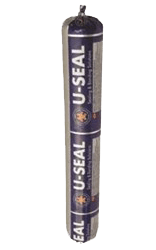U-SEAL 500
ONE-PART, POLYURETHANE ELASTIC ADHESIVE
Product Description
U-Seal 500 is a one-part, thixotropic, polyurethane based adhesive and sealant. Once extruded, it cures by
reaction to the atmospheric moisture to form a high performance, dual purpose adhesive and sealing compound
with permanent elasticity.
Main Features and Properties
- Permanently flexible
- Short cut-off string
- Stable – No shrinkage
- Bonds and seals at the same time
- Adhesion to a wide range of substrates
- Replaces rivets and mechanical fasteners
- Non-sag consistency – Good thixotropy
- Allows equalised stress transfer due to permanent elasticity.
- Vibration and sound dampening properties
- Excellent resistance to ageing, weathering – suitable for indoor and outdoor use
- Sandable and over-paintable with many water/solvent based paints (preliminary tests recommended)
Areas of Application
U-Seal 500 is a multipurpose, high performance, sealant and elastic adhesive. Bonds well to a wide variety of substrates and enables permanent elastic sealing with high adhesive strength. Suitable substrates are: concrete, wood, metal, painted surfaces and plastics. Over-paintable.
Instructions
Surface preparation: Surfaces must be clean, dry, free of water, oil, grease or rust and of sound quality. Remove
all loose particles or residues with a jet of compressed air, sandpaper or hard brush. Glass, metal and other nonporous
surfaces must be free of any coatings and wiped clean with solvent. Pre-cast panels using form-release
agents other than polyethylene film must be sandblasted or mechanically abraded and dust free.
Priming: Pre-test substrates for adhesion. Cleaners and/or primers may be required to achieve optimal adhesion.
As a rule, the substrates must be prepared in accordance with the NPT instructions; technical guidance regarding
adhesion on specific surfaces may be obtained by submitting substrate samples for analysis to our Laboratories.
Application: Pierce through the protective membrane in the front threaded section. Screw on the plastic nozzle and cut it at an angle according to the desired bead thickness and profile. Fit the cartridge into a manual or pneumatic air operated gun (provided with telescopic piston) and extrude the adhesive/sealant carefully preventing air entrapment. Once opened, packs should be used up within a relatively short time. Do not apply at temperatures below 5°C or above 40°C. The optimum operating temperature for both substrate and sealant is between 15°C and 25°C.
For Sealing purposes: In order to guarantee free movement of the sealant in joints, it is imperative that the sealant does not adhere to the bottom of the joint, therefore for correct joint caulking, a closed-cell polyethylene bead (joint backing rod) is to be placed at the proper depth. Apply appropriate primer to joint sides and observe the waiting time to avoid that any trapped solvent can form bubbles in the uncured sealant due to rising temperatures. Firmly extrude sealant and apply in the joint making sure that it is in full contact with the sides of the joint and with the backing rod at the bottom. Keep the nozzle in the sealant, continue on with a steady flow of sealant preceding the nozzle to avoid air entrapment. Avoid overlapping of sealant to eliminate entrapment of air. Sealant should be tooled to a smooth finish ensuring a full contact to the sides and back up material into the joint, this will also contribute in breaking the air bubbles which may be formed inside the sealant. Masking tape should
be used where sharp exact joint lines or exceptionally neat lines are required. Remove the tape whilst the sealant is still soft. For adhesive purposes apply in spots or bead on the prepared surfaces then firmly press the parts which have to be bonded together.
Tooling and finishing: Tooling and finishing must be carried out within the tack-free time of the sealant.
Removal: Uncured product can be removed with a white spirit or another suitable solvent. Once cured, the material can only be removed mechanically.
Over-painting: U-SEAL 500 can be over-painted. The paint must be tested for compatibility by carrying out preliminary trials. Attention must be observed with the use of alcohol or alkyd-resin since they may interfere with the curing process of the sealant and reduce the drying time of the paint itself. It should be understood that the hardness and film thickness of the paint may impair the elasticity of the sealant and lead to cracking of the paint film.
PACKAGING SHAPE
Alu-cartridge 310ml: 12 cartridges per box
Alu-PE bags 600 ml.: 20 bags per box
Alu-PE bags 400 ml. 12 bags per box (on request)
STORAGE
U-Seal 500 can be stored for 12 months in its original packing (unopened container) at 5°- 25°C in a cool, dry place. The storage temperature should not exceed 25°C for extended periods of time. Keep away from wet areas, direct sunlight and heat sources.
